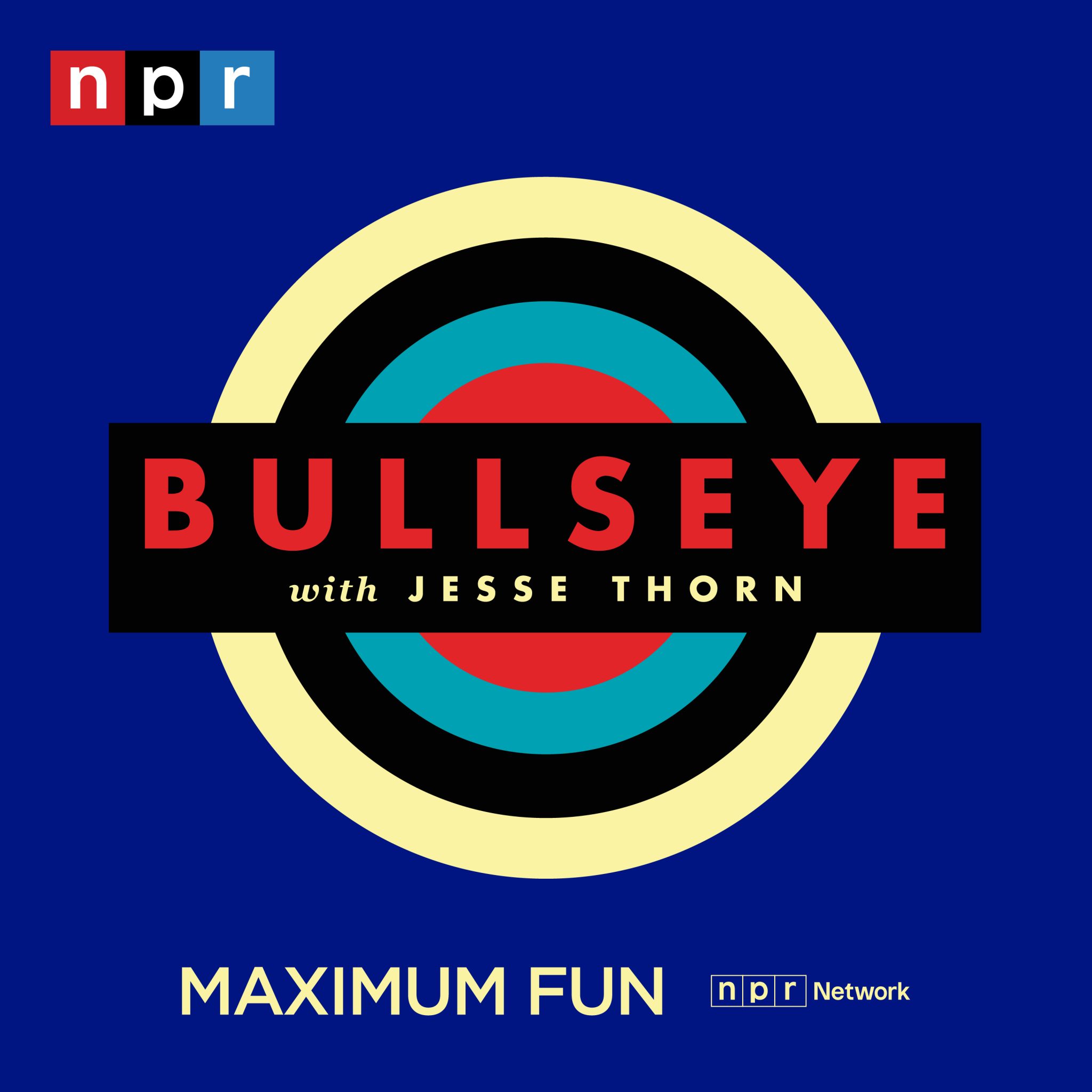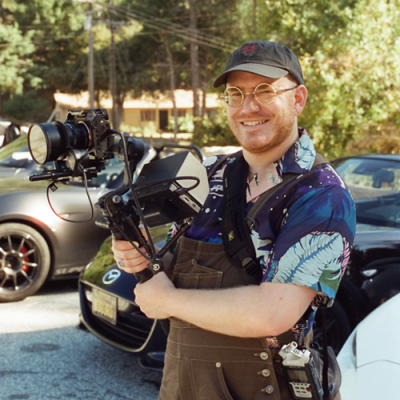Transcript
[00:00:00]
Transition: Gentle, trilling music with a steady drumbeat plays under the dialogue.
Promo: Bullseye with Jesse Thorn is a production of MaximumFun.org and is distributed by NPR.
Music: “Huddle Formation” from the album Thunder, Lightning, Strike by The Go! Team—a fast, upbeat, peppy song. Music plays as Jesse speaks, then fades out.
Jesse Thorn: It’s Bullseye. I’m Jesse Thorn. Sly Stone died about a month ago. He was 82 years old. Sly, of course, founded and sang for the funk and rock and roll act Sly & the Family Stone—one of the biggest and most consequential bands in the history of modern music. If you know Sly for anything, it’s for hits like “Thank You”, “Dance to the Music”, “Family Affair”, and about 12 dozen more. Between 1968 and 1973, Sly & the Family Stone went on a nearly unparalleled run. Then the faucet started to shut off. He cut a handful of other records in the late 1970s and early 1980s, stopped showing up to shows, and eventually quit performing altogether. He eventually faded from the public eye. After a brief reappearance and a Grammy performance in 2006, he eventually faded entirely from the public eye.
By 2011, blogs were reporting that Sly was living out of a van in Los Angeles. What happened? Was it drugs, mental illness, maybe just a need to have some peace and quiet? Maybe some of those things, maybe all of them. Sly was a hard guy to reach and an even tougher one to read. But when he passed last month, nobody talked about the dropped gigs and tabloid stories. Instead, we listened to his music; we danced and cried and felt a little better.
Rickey Vincent is a music historian who has made a career out of studying funk music. He teaches at UC Berkeley. In fact, when I was a teenager, I took his History of Funk class at San Francisco State University. I got to meet George Clinton. He came to our class. Rickey is also known as The Uhuru Maggot, host of The History of Funk on KPFA radio in Berkeley, California.
I called Dr. Vincent up to talk about Sly, his legacy, what made him special, and why we’ll never have another one like him.
Music: “Everyday People” from the album Stand! by Sly & the Family Stone.
Sometimes I’m right, and I can be wrong
My own beliefs are in my song
The butcher, the banker, the drummer, and then
Makes no difference what group I’m in
I am everyday people, yeah, yeah
(Music fades out.)
Jesse Thorn: Rickey Vincent, welcome to Bullseye. And thanks for coming here to talk to me about Sly Stone.
Rickey Vincent: I’m happy to be here, Jesse. This is—as you know, this is what I do!
Jesse Thorn: (Chuckles.) That’s true. Let’s start with this. Some people might know a little bit about Sly Stone. A lot of people recognize, dance to the music when it comes on the radio, or sing “A Simple Song” or “Everyday People”. What is the most basic thing about Sly that a casual fly-by listener who’s heard him on oldies radio might not know?
Rickey Vincent: Well, it’s not that people don’t know it—they don’t recognize it—that he reaches directly to you. This is a bad word now, but he’s inclusive! He brings everybody in. When people hear “Dance to the Music”, you’re dancing, but he’s introducing every member of the band in that three-minute song. Which is basically saying, “We’re all in this together,” without preaching. (Dropping his voice.) “We’re all in this together.”
He gives it to you in ways that— There really wasn’t a code back then. You just felt it. And a lot of the greats have a way of saying important things or complex things in an accessible way, and that was one of the main things he did. And it just—he was accessible.
Music: “Family Affair” from the album There’s a Riot Goin’ On by Sly & the Family Stone.
One child grows up to be
Somebody that just loves to learn
And another child grows up to be
Somebody you’d just love to burn
Mom loves the both of them
You see, it’s in the blood
(Music fades out.)
Rickey Vincent: It’s almost like “Family Affair”, anybody has family drama. And Sly had a way of making it feel like a particular story, but your approach—your experience—was validated as well.
Jesse Thorn: Let’s talk about the beginning of Sly’s career. Sly was from Northern California.
[00:05:00]
Sylvester Stewart was his given name. When did he start performing professionally?
Rickey Vincent: Well, he started performing in the family around age four. Because they were devout in the Church of God in Christ, which was a Christian denomination that really emphasized expression—the ecstatic in the work—and emphasized music and music ability. And Sly talked about learning every instrument just because he thought that was the thing you did. And he happened to be skilled at that. So, by the time he got to middle school, grade school—by the time he was in high school, he was in a number of bands. And he’d be in the rock band and be the best musician in the rock band. He’d be in the jazz band and be the best musician in the jazz band. And he was in a harmony singing group. And he was the best singer in the singing group, directing folks how to harmonize.
And so, that group won some talent contests, and he wound up in the studio in San Francisco and in LA moving the dials and recording, you know, with the proper pitch to make music sound like something that could grab you, while he was in high school!
Jesse Thorn: Do you have a favorite one of those recordings that he produced as like a very, very young man? Because he was in the studio producing rock records and stuff.
Rickey Vincent: Well, they were a pretty straightforward harmony group called the Viscaynes, which was named after one of those big town cars, the Biscaynes with a B. But since they’re from Vallejo, they changed it to the Viscaynes. This is what singing groups do. They name themselves after products and brands. And a lot of the songs were just straightforward. But the one that stands out from the early period was “Heavenly Angel”.
Music: “Heavenly Angel” by the Viscaynes.
Heavenly angel, say you’ll be mine
You’re my angel (angel)
All the time
We’ll be together
‘Til stars fall from night
And that’s why (that’s why)…
(Music fades out.)
Rickey Vincent: Yes, it’s a love ballad, but all of those songs were just celebrations of coming of age. And somehow Sly had a learnedness about him, even though he had an innocence about his voice that instantly grabbed people.
Jesse Thorn: How did he end up becoming a radio DJ?
Rickey Vincent: Sly talks about becoming a radio DJ, in a sense, because that was where you could put all of your skills together. Sly could sing along with the songs that he introduced. Sly could read the weather report and put some scatting in there, put some entertainment in there. And you’re essentially honing your craft on the microphone without having to arrange a band.
Clip:
(A breezy song plays in the background.)
Sly Stone: Let me step in, get to stepping, Jones. Sit, Jack. Hey, wait a minute. Hey, help man—hey, wait. Which one of these am I supposed to use, man? There’s number 131 and ain’t no 131.
Speaker: (Unclear.)
Sly Stone: (Mocks him.) This little Old Sham I’m gonna put on the people. (Laughs.) It’s 4:38 in the Sly Stone show. I’m Sly. Been here for about—what?—almost two years now? About two years?
Rickey Vincent: Radio was a way to enter the arena and be heard and be known. And back in the day, particularly on Black radio, the radio DJ had a lot of clout. They had a lot of freedom. There was a playlist of sorts. There were guidelines for what was supposed to be played, but you could introduce new music. You could introduce unexpected songs—songs never heard before that you had access to, demos and things of that nature. So, the DJ in general in the 1960s and going back to the ‘50s had a lot of sway in the community.
Jesse Thorn: We’ll wrap up with music historian Rickey Vincent after the break. We’ll be back in a moment. It’s Bullseye from MaximumFun.org and NPR.
Transition: Thumpy synth with light vocalizations.
Jesse Thorn: Welcome back to Bullseye. I’m Jesse Thorn. This episode, we’re doing something a little different. We’re taking a moment to look back on the music and life of Sly Stone. He, of course, was the founder and lead singer of Sly & the Family Stone.
[00:10:00]
He died last month at 82. Joining me to talk about his work is Rickey Vincent. Vincent is a historian and social theorist who lectures on the history of funk at UC Berkeley. He also hosts The History of Funk on KPFA radio. Let’s get back into our conversation.
So, how did Sly decide to start Sly & the Family Stone? Which seems like a very sort of purpose-driven endeavor. You know what I mean?
Rickey Vincent: Well, musicians will make music. That’s what they do. And so, Sly was developing songs; he was producing music; he was doing the radio; he was hearing what were hits on a regular basis. And he was in the community doing his thing, riding his big bikes that he had. He was hanging around. He was there. And his brother had a band—his brother, Freddie—his brother had a band called Freddie and the Stone Souls. And Larry had some musicians that he knew about, and he had kind of gotten to know this trumpet player who was in the marching band in high school in Sacramento—this young lady named Cynthia Robinson. And he knew a couple other folks that were in town.
And it all of a sudden became an opportunity that Sly couldn’t resist to fold his brother’s band in with the jam bands that he had in place and make kind of a power group that had everybody. The bass player, Larry Graham, was someone that was recommended to Sly over the radio. Someone was a radio caller and said, “You might wanna check this guy out, ’cause he can play and sing and thump and do these things” that were innovative. And so, Larry was recruited. And he was from Oakland, and he was playing with his moms in the duo. And everybody came together from a different approach, a different angle. And they got rolling.
And they actually, became a band before Rose—Sister Rose—got recruited. And they were in existence, and Sly had to pull her aside and say, “You know, that church music? We love it, but this is where you belong.” And it kind of filled out the sound, filled out the vocals, and it filled out the visuals as the band looked like it was multiracial, multi-gender. It was as inclusive as any music presentation America had ever seen to that point.
Jesse Thorn: I think that’s a really consequential thing. He wanted the band as it stepped on stage, before they started playing, to mean something. What did he want that to mean? When those players all filed onto the stage, and the drummer was a white guy, and there were women in the group, and there—you know what I mean? What did he want that to mean?
Rickey Vincent: It was time to move past the authoritarian ethos of music entertainment. Going back to the big bands, the swing bands, there was always a leader and an anonymous regiment of soldiers, if you will. A lot of those bands, a lot of the R&B bands that preceded Sly, they were wearing uniforms. And it was in part to show organization. And that’s something that was part of the way of breaking through stereotypes of the so-called negro was that they couldn’t organize; they couldn’t do things together. And so, it meant something to show you had an organized, sophisticated group of people. And James Brown was serious about that, and he made sure his bands had tight, clean uniforms and a tight, clean sound.
But it was—a new time was emerging. It was a different day, and it was more important to focus on the individual talents, the individual look, the individual sound, the individual vibe, the individual aspirations of the players in the group.
Jesse Thorn: When Sly & the Family Stone got their first record deal and recorded A Whole New Thing, their first album, what was different about that record musically? Like, what was distinctive about what they were doing on the record?
Rickey Vincent: Most of the R&B records at that time—Motown was the king of the formula of a three-minute song. Maybe you have six tracks on a side. And most of them were interchangeable—sonically, thematically, in terms of the instrumentation.
[00:15:00]
Occasionally a tune resonates, and it’s the hit, but that doesn’t make it dramatically different from the four or five tunes that followed. Stax Records was kind of coming on the heels of Motown. They were from Memphis. They had more of a southern, down-home feel. But a lot of their songs kind of had that kind of blues structure and went for the young people entertainment vibe. And people enjoyed the music. And then over there on the West coast, these psychedelic people were making sounds a lot of people, at first, didn’t understand.
Jesse Thorn: One of my favorite Sly & the Family Stone songs ever recorded is the first song from their first album, A Whole New Thing, called “Underdog”. Describe to me what was different about the way that first Sly & Family Stone album sounded compared to Motown or Stax or, for that matter, The Jefferson Airplane.
Rickey Vincent: (Chuckles.) Well, in soul music, a formula had been developed by 1967, and Motown was at the top of the heap. And Stax was close behind with the more sort of soulful, down-home feel. Sly & the Family Stone coming out of the West Coast, something a little less expected. They weren’t really weighed down with expectations. And if that meant a flash in the pan, maybe so. But then all of a sudden, here comes the first record and the first song on the first record, “Underdog”, which shouts at you—which double-time rhymes in there like it’s a hip-hop track, and the beat is punishing, and it’s coming at you with all this positive energy. But the message is really a rough and rugged sort of discussion of what the struggle is about.
Music: “Underdog” from the album A Whole New Thing by Sly & the Family Stone.
I know how it feels to expect to get
A fair shake, but they won’t let you forget
That you’re the underdog and you’ve got to be twice as good (Yeah, yeah)
Even if you’re never right
They get uptight when you get too bright
Or you might start thinking too much (Yeah, yeah)
I know how it feels when you know you’re real
But every other time you get up and get a raw deal, yeah (Yeah, yeah)
(Music fades out.)
Rickey Vincent: That was an awakening for people that, “Yo, these guys are no joke.” That we may not hear from them again, but they sure are creative. But the word was—you know, they pulled his coat and said, “Sly, you better give us a hit, something you can dance to, if you wanna stay in this arena.” And so, he gave ’em something they could dance to. That was “Dance to the Music”.
Jesse Thorn: That first Sly & the Family Stone record is a big enough success to get them a second record, but it isn’t the kind of success that they’re hoping for. The second album is Dance to the Music. Dance to the Music, of course, features the title track “Dance to the Music”, which in my book is one of the ten best pop records of the 20th century and one of my favorite songs ever. It’s also a song that—I didn’t know until recently—was like almost a taunt to the idea that record company people were telling Sly, “You gotta make simple pop music that people can enjoy and dance to.” (Laughs.)
Rickey Vincent: For somebody that had as many influences and interesting approaches up his sleeve that Sylvester Stewart had, it would be seen as a departure to sit down and do a lobotomized, simple, one-foot-stepping dance track. It just—that’s a struggle for the eclectic artists, for the elitist, for this music snob. They don’t want to do that. And it seemed that Sly broke that barrier as well. And it’s like you can make pop music that doesn’t insult the intelligence of the audience.
Music: “Dance to the Music” from the album Dance to the Music by Sly & the Family Stone.
Dance to the music
Dance to the music
Dance to the music
Dance to the music (Hey, Greg!) What?
All we need is a drummer
For people who only need a beat, yeah
(Music fades out.)
Jesse Thorn: I think the absolute heart of the prime of the classic version of commercial Sly & the Family Stone is probably the record Stand!. It was a pile of hits, as well as the seeds of what the band was about to become.
[00:20:00]
And Sly Stone did a lot. It is a sort of reinterpretation of “Higher” from a previous record from a few years earlier.
Music: “I Want to Take You Higher” from the album Stand! by Sly & the Family Stone.
Beat is getting stronger
Music getting longer, too
Music is a-flashin’ me
(Music fades out.)
Jesse Thorn: That song is the song that, if you’ve seen Sly & the Family Stone in the clips package on a TV documentary about the ‘60s or something, you’ve probably seen them perform. What was special about that record?
Rickey Vincent: “I Want to Take You Higher” was like the anthem that rose above all the other anthems. Because it was everything Sly and Family Stone was about. Sly could do things that were joyous at one end, that were hardcore at another end—in some cases on the same album. But in terms of “I Want to Take You Higher”, it was in the same song! The vibe of it was so energetic, but there was nothing escapist about it. It was right here and right now.
Music: “I Want to Take You Higher”
Don’t ya wanna get higher?
Don’t ya wanna get higher?
Baby, baby, baby, light my fire (Woo)
I wanna take you higher
(Music fades out.)
Rickey Vincent: And if there was ever a tune that rode that amorphous, hard-to-explain definition of a fence between rock and roll and rhythm and blues, that was the tune.
Jesse Thorn: One of the last times that I saw my aunt Claudia, who died a few years ago but was one of my closest family members—my mother’s best friend—we were in her apartment in Washington DC. Important context to this is that she was African American. And she’s digging for something through a closet, and she pulls like a glass peace sign out of the closet. She says, “Oh man, Jesse, we had this in the back window when we drove to Woodstock.”
(Rickey chuckles.)
And then she put it back. And then she sort of looked up in the air for a second, and then she said, “I’ll tell you what, Jesse. We got there, saw those White people, and said, ‘I think we’re the only ones here to see Sly.’” (Chuckles.) And Sly & the Family Stone’s performance at Woodstock is—you know, along with probably Jimi Hendrix playing “The Star-Spangled Banner”—one of the cultural highlights of that which we think of when we think of the idea of the 1960s.
Rickey Vincent: It definitely is. And it seemed like a lot of Sly’s career is a moment sort of out of the ether, and it smacks everybody. But it was something that—from his life path, that this was right in line with what he did as a performer. As anybody that was a high-quality Black music entertainer, you knew your job was to go into the venue and turn that sucker out and get the people to do what they hadn’t done before. Get them to jump up, get them to get out of their sleeping bag to turn their little lighters on. Whatever it was. And of course, he had done that at the Apollo Theater, as he had done that in Harlem at the Harlem Arts Festival that same summer. He was the only Black artist that did the Summer of Soul and Woodstock that same summer. But Sly was gonna get people up and out of their seats, in some cases out on the street, whatever it took to make it a memorable experience to get people to do something together.
Music: “Everyday People” performed live.
Sometimes I’m right and I can be wrong
My own beliefs are in my song
The butcher, the banker, the drummer and then
Makes no difference what group I’m in
I am everyday people, yeah, yeah
There is a blue one who can’t accept the green one
For living with a fat one, trying to be a skinny one
Different strokes for different folks
And so on and so on…
(Music fades out.)
Jesse Thorn: In contrast to the records that had come fast and furious over the preceding four years, it took a couple of years for the next record. What’s special about There’s a Riot Goin’ On that was so compelling that it was worth waiting years for?
Rickey Vincent: Well, There’s a Riot Goin’ On was unlike anything anyone had ever done before.
[00:25:00]
And you can say, “Well, that’s because he was already well known. So, we expected it. And there are underground artists that were doing free form, freestyle social consciousness in their music as well.”
And maybe that’s the case. But they weren’t gripping you the way Sly was gripping you. “Family Affair”, “My Only Weapon is My Pen”, “Love and Hate”, and “Brave & Strong”—there was just so much being said; it was just being said in a different way. And to innovate at the stage that he was in? There are very few artists that can innovate while they’re at number one and stay at number one, and that’s what Sly did.
Music: “Brave & Strong” from the album There’s a Riot Goin’ On by Sly & the Family Stone.
Frightened faces to the wall
Oh, can’t you hear your mama call?
The brave and strong survive, oh yeah
When you walk
Know where you’re walking
When you talk, oh
The brave and strong survive
(Music fades out.)
Rickey Vincent: It was magnificent in its own way. But you have to be able to see colors that really aren’t on that scale of five colors anymore. You have to see things that are different, ’cause Sly was seeing things that are different. And he had to work with things that were different. ‘Cause there wasn’t much Larry. And you can say, “Well, he innovated with the drum machine.” He innovated with the drum machine because Greg Errico had left, and he didn’t have Greg Errico’s sound to sort of embed the joy underneath what his sound was. But Sly knew what he was doing.
Jesse Thorn: We’ve got a lot more to come with Rickey Vincent. After the break, we’ll talk about Sly Stone’s gradual exit from show business and why he never really came back. It’s Bullseye from MaximumFun.org and NPR.
Promo:
Music: “Building Wings” by Rhett Miller, a spirited acoustic guitar number.
John Moe: One thing we all have in common: we all have a mind.
Speaker 1: It makes me so scared, because I’m like, “When is the bad thing going to happen?”
John Moe: And minds can be kind of unpredictable and eccentric.
Speaker 2: Everybody wants to hear that they’re not alone. Everybody wants to hear that someone else has those same thoughts.
John Moe: Depresh Mode with John Moe is about how interesting minds intersect with the lives and work of the people who have them: comedians, authors, experts, all sorts of folks trying to make sense of their world.
Speaker 3: It’s not admitting something bad if you say, “This is scary.”
John Moe: Depresh Mode with John Moe, every Monday at MaximumFun.org or wherever you get podcasts.
(Music fades out.)
Transition: Thumpy synth with a syncopated beat.
Jesse Thorn: It’s Bullseye. I’m Jesse Thorn. I’m talking with Rickey Vincent. He’s a professor of music history. We’re remembering the life and work of the great Sly Stone.
I have to say that my favorite Sly & the Family Stone record—in fact, my favorite record—is Fresh, which is the record that came out after There’s a Riot Goin’ On. And as Sly continues to record and as he struggles with addiction and his health over the course of the 1970s, things get messier and messier and more scattershot on the records. But Fresh is an album that—despite the fact that people were quitting the band left and right, and not sure whether they liked Sly, and so on and so forth—is such a beautiful distillation of his loneliness and tenderness.
Rickey Vincent: Yes. His multi-dimensions. There is no more earnest song than “If You Want Me to Stay” in the pop lexicon. ‘Cause it speaks a personal story that is also universal for everyone. And you just—you know. You felt that that was about the most authentic track there. But there were so many. And it was poignant. It was joyous. It was strong, but very tender at the same time. And it was all these things. And I remember when the record came out, it seemed audacious that he would be jumping, and the cover’s all brightly colored. And I’m like, “Well, maybe they just—promoters just wanted to fake you into thinking it was fresh.”
But Sly had the ability—like Black music for the last century, if not longer—could make something fresh out of a hopeless situation. And I got that sense from the outside in. And then once you’re in it, you forget all of that. And you just—you’re in it, and it’s a lovely thing.
Jesse Thorn: Sly Stone made records through the ‘70s.
[00:30:00]
Less frequently in the end of the ‘70s than he had in the beginning. But for the most part, the mid-‘70s were the end of his public career. To what extent do you think that was his choice?
Rickey Vincent: I think Sly, despite what he might’ve desired out of fame and popularity—I think the parts of himself were like, “Dial it back, pull it back.” There was always a sense that if Sly wanted to dominate sonically with the music and with the craft, he could. But he saw the beast. He went to the top of the mountain, and he saw the beast. And that’s not necessarily something anybody wants to really cohabit with. Because he had no predecessors, in terms of doing that type of thing.
So, it’s a bit of a riddle. Did he fail to stay on the top of the charts, or was he just going through the motions, protecting his peace?
Jesse Thorn: I mean Sly Stone, by all accounts, recorded a fair amount later in life. Do you think that there is a secret stash somewhere?
Rickey Vincent: Oh, for sure. There’s gonna be plenty of extras and bootlegs and sessions that are gonna surface. It’s just a matter of how do you wanna approach it? For some fans of, any artist, anything off the grid or from the from the vaults is gonna be a joy. At some point, folks are gonna be looking for, you know, an AirPlay ready session that they could kind of reimagine, you know, or reinsert. Or it can just get redone. Like Natalie Cole did the duet with her father years after he passed, “Unforgettable”.
And there’s something so timeless about Sly’s music, it won’t feel dated or old. It’ll feel tricky and silly and nutty and edgy and brilliant. And then it’ll be up to us to mess with it with our own consumption of it. You know, how are we gonna take this in? But definitely in terms of Sly’s impact, in terms of Sly’s ability to resonate with the times and help us make sense of today’s times, all of that didn’t change, doesn’t change, and won’t change in the future.
Jesse Thorn: If you were gonna describe how Sly stone changed American popular music, and you had piece of binder paper to do it on (chuckles), what would you write?
Rickey Vincent: Sly created the musical palette for the unity that America was seeking at its most tumultuous moment.
Jesse Thorn: Do you think that Sly Stone has found his appropriate place in the pantheon of American popular music, or do you think it’s still important to make an argument for that?
Rickey Vincent: I think the argument’s been made. The first documentary on funk music was in 1993 by this guy in England named Lenny Henry. And there was a TV show called The South Bank Show. He took over The South Bank Show—which was, perhaps, a topical issues type of talk show—but he turned it into a wild funk documentary that went from the 1940s, and then James Brown, and then Bootsy, and George Clinton, and Prince, and then Public Enemy. And he covered all these things. And they left a Sly Stone out! Sly wasn’t in this. And that was 1993.
Aside from that, there’s been a steady path of recognition of Sly’s music, Sly’s life, Sly’s work, Sly’s image over the ensuing decades to now. I think he’s recognized in that way. And if there’s ever a great sort of advantage to all the technology and all these new narratives, and revisiting, and access to music now—it’s not healthy for the musicians themselves, but for the curators and the investigators, it’s there. And Sly Stone’s genius speaks for itself.
Jesse Thorn: Well, Rickey Vincent, it’s so nice to see you again, lo these many years later.
[00:35:00]
And thanks for talking to me about one of the greatest recording artists of the 20th Century, and certainly one of my favorites. It’s nice to talk to you again.
Rickey Vincent: It’s been my pleasure, Jesse. And I’m glad that you’re still tuned in.
Jesse Thorn: Rickey Vincent. Brilliant historian and social theorist, wonderful writer. You should check out his books, Funk: The Music, The People, and the Rhythm of the One, and Party Music: The Inside Story of the Black Panthers’ Band and How Black Power Transformed Soul Music. He teaches at UC Berkeley. He is also DJ on KPFA radio in the San Francisco Bay area, where he is known as The Uhuru Maggot. If you live up there, you can hear his show live, 94.1 FM every Friday night at 10.
Let’s go out with one more song from Sly & the Family Stone. This is my favorite song of all time from Fresh, my favorite album of all time. It’s “If You Want Me to Stay”.
Music: “If You Want Me to Stay” from the album Fresh by Sly & the Family Stone.
If you want me to stay
I’ll be around today
To be available for you to see
But I am about to go
And then you’ll know
For me to stay here, I got to be me
You’ll never be in doubt…
(Music continues under the dialogue.)
Jesse Thorn: That’s the end of another episode of Bullseye. Bullseye was created in the homes of me and the staff of Maximum Fun—as well as at Maximum Fun HQ, overlooking beautiful MacArthur Park in Los Angeles, California.
Our show is produced by speaking into microphones. Our senior producer is Kevin Ferguson. Our producers, Jesus Ambrosio and Richard Robey. Our production fellow at Maximum Fun is Hannah Moroz. Our video producer is Daniel Speer. Special thanks this week to Rickey Vincent for engineering his own interview at KPFA in Berkeley, California. Thank you, Rickey. Thank you, KPFA. We get booking help from Mara Davis. Our interstitial music comes from our friend Dan Wally, also known as DJW. You can find his music at DJWsounds.bandcamp.com.
Our theme music was written and recorded by The Go! Team. The song is called “Huddle Formation”. Thanks to The Go! Team. Thanks to their label, Memphis Industries, for letting us use that.
You can follow Bullseye on Instagram, TikTok, and YouTube—where you’ll find full video from just about all our interviews, including the ones you heard this week. And (laughing) can I recommend? Go to our YouTube channel and check out the comments about our interview with Mark Hamill? It turns out that Star Wars fans are very passionate about Luke Skywalker!
Okay. I think that’s about it. Just remember: all great radio hosts have a signature signoff.
Music:
And when you see me again
I hope that you have been
The kind of person that you really are now…
(Music fades out.)
Promo: Bullseye with Jesse Thorn is a production of MaximumFun.org and is distributed by NPR.
About the show
Bullseye is a celebration of the best of arts and culture in public radio form. Host Jesse Thorn sifts the wheat from the chaff to bring you in-depth interviews with the most revered and revolutionary minds in our culture.
Bullseye has been featured in Time, The New York Times, GQ and McSweeney’s, which called it “the kind of show people listen to in a more perfect world.” Since April 2013, the show has been distributed by NPR.
If you would like to pitch a guest for Bullseye, please CLICK HERE. You can also follow Bullseye on Twitter, YouTube, and Facebook. For more about Bullseye and to see a list of stations that carry it, please click here.
Get in touch with the show
People
How to listen
Stream or download episodes directly from our website, or listen via your favorite podcatcher!






